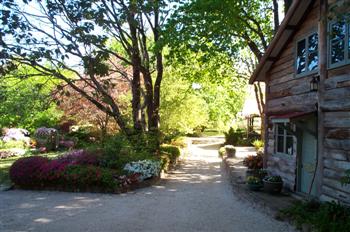Uncategorised
Artists in Residence
- Details
Artist in Residence, The Old School Mt Wilson
beauty, diversity, tranquility
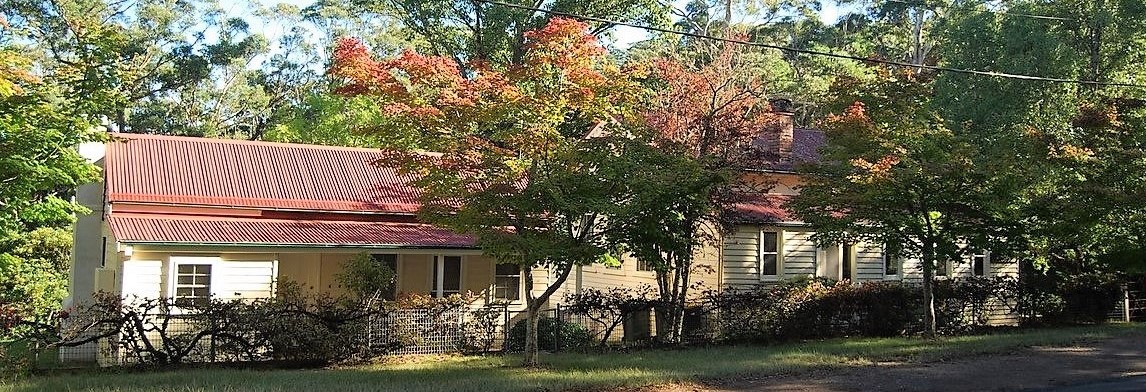 The Old School, Mount Wilson commenced an Artist in Residence program in 2019. This is a volunteer based, not for profit organisation aiming to share the beauty, diversity and tranquility of Mount Wilson, providing an opportunity for artists to work, be supported by and engage with the local community.
The Old School, Mount Wilson commenced an Artist in Residence program in 2019. This is a volunteer based, not for profit organisation aiming to share the beauty, diversity and tranquility of Mount Wilson, providing an opportunity for artists to work, be supported by and engage with the local community.
The program provides residency, accommodation and studio, for one month for both emerging and established artists and suits musicians/composers, writers, visual and textile artists.
Each resident will give a community engagement event.
![]() Artist in Residence on Facebook
Artist in Residence on Facebook
![]()
Artist in Residence on Instagram
Applications are now open and close Friday 31 May
for the October 2024 to June 2025 period.
There is no residency offered for April

|
For more information or to be added to our email list, please contact This email address is being protected from spambots. You need JavaScript enabled to view it.
The Old School Mt Wilson gratefully acknowledges the commitment and generosity of our supporters.
Anne de Salis & Martin Barge
Nancy Fox AM & Bruce Arnold
Steve Gracie
Griffin Foundation
Mary Holt OAM
Joe & Elizabeth Montano
Anon (1)
Please consider making a donation towards the future of the Artists in Residence program at The Old School. Your gift, of any size, is a vital contribution to the program’s future.
All gifts over $2 are fully tax-deductible.
To support The Old School Artists in Residence program, you can:
- Make a direct deposit to:
- Account name: The Old School Mt Wilson Public Fund
- BSB: 082-678
- Account: 31 143 7891
- Email: This email address is being protected from spambots. You need JavaScript enabled to view it.
Please include your name in the description to receive your tax-deductible receipt.
Residencies for November 2023 to June 2024
Ward O'Neill
Johanna Hildebrandt
Frankie Dyson Reilly
Anna Spencer
Peter McLean
Frankie Meaden
Residencies for November 2022 to June 2023
Belle Bregovic emerging poet/classical pianist and guitarist Eitan Muir during their residency will delve deep into their craft and develop new performance works, culminating in a premier performancefor the Mt Wilson local community
Helen Pitt is a senior writer at the Sydney Morning heraldand author of The House, the extraordinary story of the Sydney opera House and the people who built it. This residency will be her first attempt at writing fiction, working on an idea about French female explorers in NSW
Helen Begley is a song writer, composer, performer, teacher and facilitator, currently working on a trilogyof musical performance pieces that explore the stories of femaile immigration to Australia in the 1930s, "Voyage", "Wild" and "Wrecked". During her residency she will be working on "Wild" , the story of immigrant Martha Wild.
Sharon Peoples is a textile artist oscillating between hand and machine embroidery to examine issues. She is energised and draws inspiration from gardens. For her residency she proposes to take time to researchand explore the birds that are present or migrate through the Mt Wilson 'garden'
Anna Glynn artist and Peter Dalmazzo biologist will explore the Blue Mountains basalt forest endangered ecological community creating artwork to focus attention and highlight a stunning and complex environment
Marynes Avila is a multi-award winning artist concerned with socially engaged practice who creates work that specifically responds to site and community
Read the artist statements.......
Residencies for November 2021 to May 2022
Cadance Bell is an author, writer, producer and director.
Brad Gill is a musician and composer
Ariella Van Luyn is a writer
Natasha Dubler is a multidisciplinary artist working across sound installation, music performance and small sculpture.
Anna Glynn artist & Peter Dalmazzo biologist
Jennifer Keeler-Milne is a visual artist.
Read the artist statements here
Residencies for October 2020 to June 2021
Jane Guthleben is a visual artist whose practice involves a fascination with C17th Dutch still life paintings and how to reimagine them in an Australian context
Jody Graham is a multidiscipline artist, whose artwork commemorates loss and memory. Her purpose is to conserve valuable stories and contribute creatively to the Australian bushfire history.
Leah Bullen is a visual artist whose practice explores various locations that recreate and curate the natural world, such as gardens.
Julie Thorndyke is a writer
Read the artists statements......
Residencies for October 2019 to May 2020
LeAnne Vincent a photo based visual artist read more.....
Leisel Mott is a landscape painter
Tristan Coelho composer and Emily Granger harpist
Troth - Amelia Besseney and Cooper Bowman together they fashion ethereal soundscapes from field recordings, vocals, electronics, zither, tape loops and sampled percussion and piano
Mandy Beaumont is a novelist
Lynne Ainsworth will be working on her memoir 'Someone Must Pay'
Read the artists statements......



Current Bushfire Status
- Details
Update about the Gospers Mountain Fire to the north of us, posted Wednesday, 11 December.
Gospers Mountain Bushfire Update - Plan to begin backburning today.
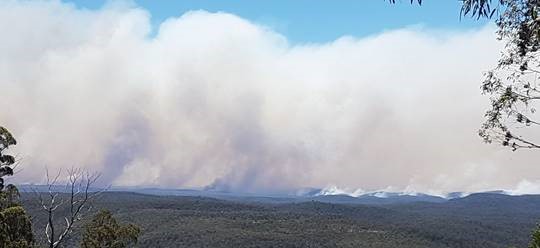
The Gospers Mountain bushfire seen yesterday from Smiths Hill was about 6 kms from Mount Irvine
The Fire
While we have a good weather window MWMIRFS Brigade will commence back burning into the area below Mount Irvine today to take advantage of the better conditions for creating a safety burnt area around Mt Irvine. This will involve lighting the bush from the fire trails around Mount Irvine then Mount Wilson to remove the fuel between the villages and the Gospers Mountain fire thereby protecting property in the villages. The back burn is a lower intensity burn usually lit at night and going downhill so as to reduce the impact on the surrounding bush while removing the fuel and protecting the area from the bushfire coming into the villages on a bad day.
On Tuesday the fire was holding on Bungleboori Creek (see yesterday’s Update map), north of Mt Wilson / Mt Irvine, but quite active on the Newnes Plateau. The back burn started at Mountain Lagoon has progressed as far as Bilpin. After a very hot day yesterday we are entering a good weather window until about Friday.
Access to the Mounts
A road block at Mt Wilson Road and the Bells Line of Road will restrict access to all vehicles other than residents and emergency services. Expect this to be in place for a couple of weeks.
Letters of authority were distributed last night to all residents providing access to named people on the presentation of the letter and ID like a local rates’ notice or a driver’s licence. If you need an authority for anyone else (other than Mount Wilson or Mount Irvine residents) please email to This email address is being protected from spambots. You need JavaScript enabled to view it. stating: first name, family name and email address. A personalised authority letter will be sent to the nominated person.
The trigger point for fire plans
The start of backburning is the trigger point for people to carry out their fire plans. If you plan to leave, today is the time to relocate. Leave, stay or come to the Mounts this is also the time to contact your Street Coordinator and tell them what you will be doing. A fire warning message may be sent to all mobile phones in the area when fire reaches a preset zone around both villages . Do not be alarmed by this, just follow the prompts and check with your street coordinator if the situation or conditions may have changed.
Once backburning starts we will see an increase of smoke in the area. From today expect increased movement of trucks, activity around both community halls and fire stations and road closures in areas as the backburn progress from Mount Irvine to Mount Wilson and on along Mt Wilson Road to Bells Line of Road.
Please slow down on the local roads, if possible pull over and let tucks pass. Do not enter the fire trails or the burn area as there will be many hazards, machinery operating, steep trails, falling trees and hot ash beds.
Anyone who would like to assist with Catering or Station work please contact the Brigade Station Officer on 4756 2168.
Peter Raines
Senior Deputy Captain
Mt Wilson-Mt Irvine RF Brigade
Map of Fires in NSW with the current status of each fire, Fires Near Me.
The map can be zoomed to show fires in our area.
Birds in Mt Wilson
- Details
Ducks and swans
Australasian darter
Herons and egrets
White-necked heron
Ibises and spoonbills
Straw-necked ibis
Masked lapwing
Eagles, kites and goshawks
Brown goshawk
Grey goshawk
Wedge-tailed eagle
Pigeons and doves
White-headed pigeon
Brown cuckoo dove
Common bronzewing
Brush bronzewing
Crested pigeon
Bar-shouldered dove
Wonga pigeon
Cockatoos
Yellow-tailed black cockatoo
Gang-gang cockatoo
Parrots and lorikeets
Galah
Rainbow lorikeet
Australian king parrot
Crimson rosella
Eastern rosella
Cuckoos
Fan-tailed cuckoo
Shining bronze-cuckoo
Horsfield’s bronze-cuckoo
Channel-billed cuckoo
Owls
Powerful owl
Southern boobook
Sooty owl
Eastern barn owl
Frogmouths and nightjars
Tawny frogmouth
Kingfishers
Azure kingfisher
Laughing kookaburra
Superb lyrebird
Treecreepers
White-throated treecreeper
Red-browed treecreeper
Fairy-wrens
Superb fairy-wren
Variegated fairy-wren
Pardalotes
Spotted pardalote
Scrubwrens, thornbills and gerygones
Pilotbird
Rockwarbler
Yellow-throated scrubwren
White-browed scrubwren
Large-billed scrubwren
Brown gerygone
Brown thornbill
Striated thornbill
Honeyeaters
Red wattlebird
Little wattlebird
Bell miner
Lewin’s honeyeater
Yellow-faced honeyeater
White-eared honeyeater
White-naped honeyeater
Crescent honeyeater
New Holland honeyeater
Tawny-crowned honeyeater
Eastern spinebill
Jacky winter
Australian robins
Scarlet robin
Red-capped robin
Flame robin
Rose robin
Eastern yellow robin
Eastern whipbird
Whistlers and allies
Golden whistler
Grey shrike-thrush
Crested shrike-tit
Black-faced monarch
Fantails
Grey fantail
Rufous fantail
Willie wagtail
Cuckoo-shrikes
Black-faced cuckoo-shrike
Currawongs and allies
Grey butcherbird
Pied butcherbird
Pied currawong
Grey currawong
Australian magpie
Ravens and crows
Australian raven
White-winged chough
Satin bowerbird
Finches
Red-browed finch
Mistletoebird
Swallows and martins
Welcome swallow
Tree martin
Fairy martin
Songlarks
Rufous songlark
Brown songlark
Silvereye
Bassian thrush
Introduced birds
Red-whiskered bulbul
Common blackbird
Common starling
Japanese Honeysuckle (Lonicera japonica)
- Details
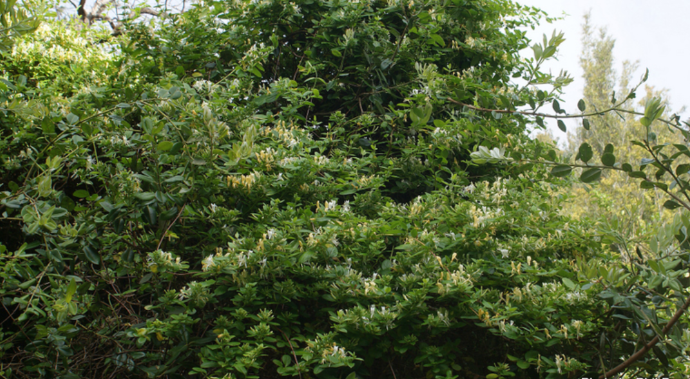 A native of China and Japan. Japanese Honeysuckle is a vigorous climber with soft green leaves and pale yellow, sweetly scented flowers which self layers and quickly grows up and over shrubs and small trees, smothering them. The black berries are carried by the birds.
A native of China and Japan. Japanese Honeysuckle is a vigorous climber with soft green leaves and pale yellow, sweetly scented flowers which self layers and quickly grows up and over shrubs and small trees, smothering them. The black berries are carried by the birds.
Japanese Honeysuckle is a vigorous, fast growing scrambling and climbing shrub with distinctive pinkish new stems. Old stems can become thick and gnarly.
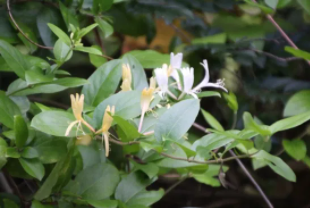
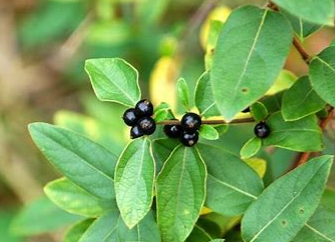 Spring is a good time to identify Japanese Honeysuckle, a creeper with its distinctive small yellow cream to white flowers with a pink tube. Flowers occur in pairs and mostly in spring to autumn. Flowers are fragrant and nectar-filled.
Spring is a good time to identify Japanese Honeysuckle, a creeper with its distinctive small yellow cream to white flowers with a pink tube. Flowers occur in pairs and mostly in spring to autumn. Flowers are fragrant and nectar-filled.
Small shiny black berries 6–10 mm long occur in autumn.
Impact on bushland
Japanese Honeysuckle grows rapidly and forms a dense shade over shrubs and low canopy trees, blocking the light, breaking branches and causing loss of biodiversity.
Control
Japanese Honeysuckle twines in and around other plants, making it difficult to control.
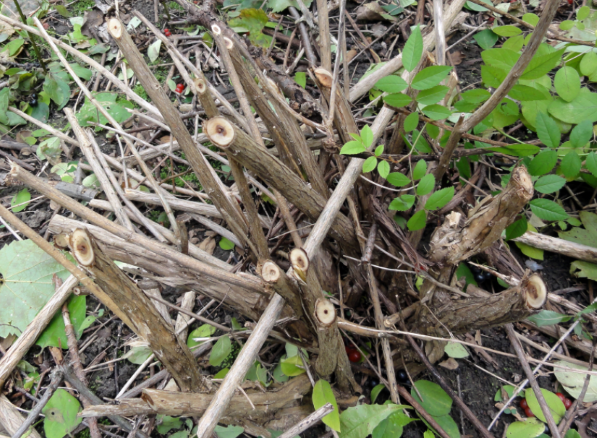
Vines climbing up shrubs or trees:
- Scrape each stem as far as possible and paint; suspended vines can then be cut and left in place.
- Suspended vines are easily identified as they look like gnarly paperbark vines.
- Cut and paint large crowns and scrape and paint as many roots as possible.
Vines growing on the ground:
- Pull out by hand, making sure all root and stem parts are removed. Cut material can be spread out off the ground. Once dead, it will decompose in place.
- Where the foliage is dense, treat with herbicide if there are no native plants or water nearby.
Berries are spread by birds, so treat plants before they fruit.
Do not pull dead or alive vines out of trees as this may damage the tree and it may be habitat for microbats and other small animals.


